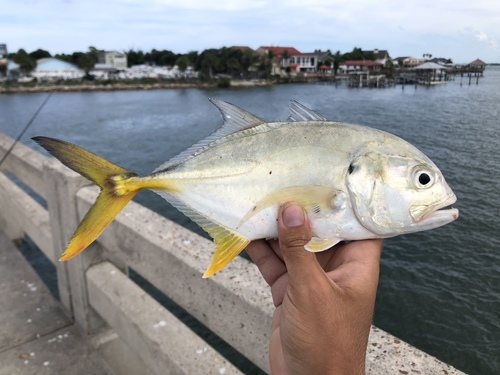
Crevalle Jack
The Atlantic bluefin tuna (Thunnus thynnus) is one of the largest and most powerful bony fishes in the world. Highly prized for its meat, this magnificent species plays a crucial role in the marine ecosystem. It's a top predator, known for its incredible speed, endurance, and transoceanic migrations.
2 17 years
Lifespan
124.0 cm
Length
Least Concern
Conservation Status
50 km/h
Swimming speed
Carnivorous
Diet
Local Migration, Seasonal Migration
Migration
Appearance Overview
The Atlantic bluefin tuna is a large, streamlined fish with a metallic blue body and a silvery underside.
Color
Dark metallic blue on top with a silvery underside
Body
Torpedo-shaped, built for speed and endurance
Fins
Two dorsal fins, the first is yellow or blueish, the second is reddish-brown
Length
up to 13 feet (4 meters)
Weight
up to 2,000 lbs (907 kg)
Diet
Carnivorous, feeding on fish, squid, crustaceans, and eels.
Feeding Behavior
Highly active predator that uses speed and powerful muscles to chase down prey, often hunting cooperatively.
Social Behavior
Forms schools, sometimes with other tuna species, especially when young; larger individuals are more solitary.
Commercial Relevance
Extremely high value, especially in sushi and sashimi markets, where it is considered a delicacy.
Conservation measures
Subject to international fishing quotas and management plans, marine protected areas, and efforts to reduce bycatch.
Status
Endangered (Varies by population segment; some are considered critically endangered)
Threats
Overfishing (historically and ongoing), bycatch in other fisheries, climate change affecting prey distribution.
Habitat Distribution
Depth Range
0-1,000 meters (typically in the upper layers, but can dive deep)
Geographic Range
Atlantic Ocean, Mediterranean Sea, Gulf of Mexico; highly migratory across these regions.
Preferred Environment
Temperate and subtropical waters; open ocean, often near continental shelves and slopes.
Reproduction and Life Cycle
Breeding Habits
Spawns in warm waters, primarily in the Mediterranean Sea and the Gulf of Mexico; spawning is seasonal.
Development Stages
Eggs hatch into larvae; juveniles grow rapidly, feeding and migrating; they develop into adults over several years.
Fecundity
Females can produce up to 30 million eggs per spawning season, releasing them in batches.
Maturity Age
Matures at 4-8 years (Mediterranean) or 8-12 years (Western Atlantic).
Faqs about Crevalle Jack
How long do Atlantic bluefin tuna live?
Atlantic bluefin tuna can live up to 40 years.
Where are Atlantic bluefin tuna found?
They are found in the Atlantic Ocean, from the Mediterranean Sea to the Gulf of Mexico and the coasts of North America and Europe.
Are Atlantic bluefin tuna migratory?
Yes, they are highly migratory, traveling vast distances across the Atlantic for feeding and spawning.
What do Atlantic bluefin tuna eat?
They primarily eat fish, squid, crustaceans, and eels.
Why are Atlantic bluefin tuna endangered?
Overfishing has severely depleted their populations, making them a target of conservation efforts.
When do Atlantic bluefin tuna reach maturity?
They reach maturity between 4-8 years, depending on the population.
How many eggs can a female bluefin tuna lay?
Females can release millions of eggs per spawning season.
How are bluefin tuna adapted for speed?
Their streamlined body, powerful muscles, and specialized fins enable them to swim at high speeds.
Are bluefin tuna warm-blooded?
Bluefin tuna are warm-blooded, which is unusual for fish, allowing them to maintain a higher body temperature than the surrounding water.
Copyright @ Nature Style Limited. All Rights Reserved.
 English
English